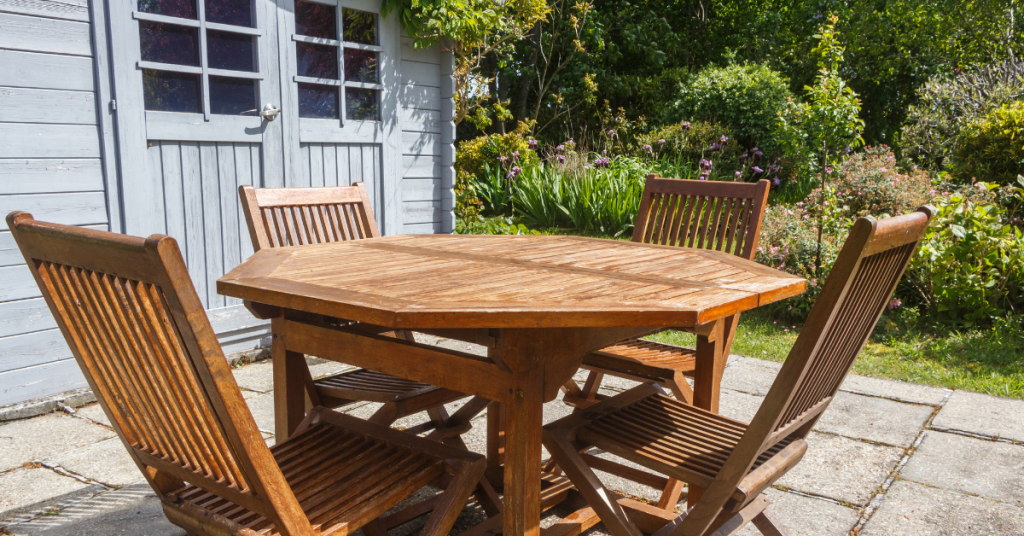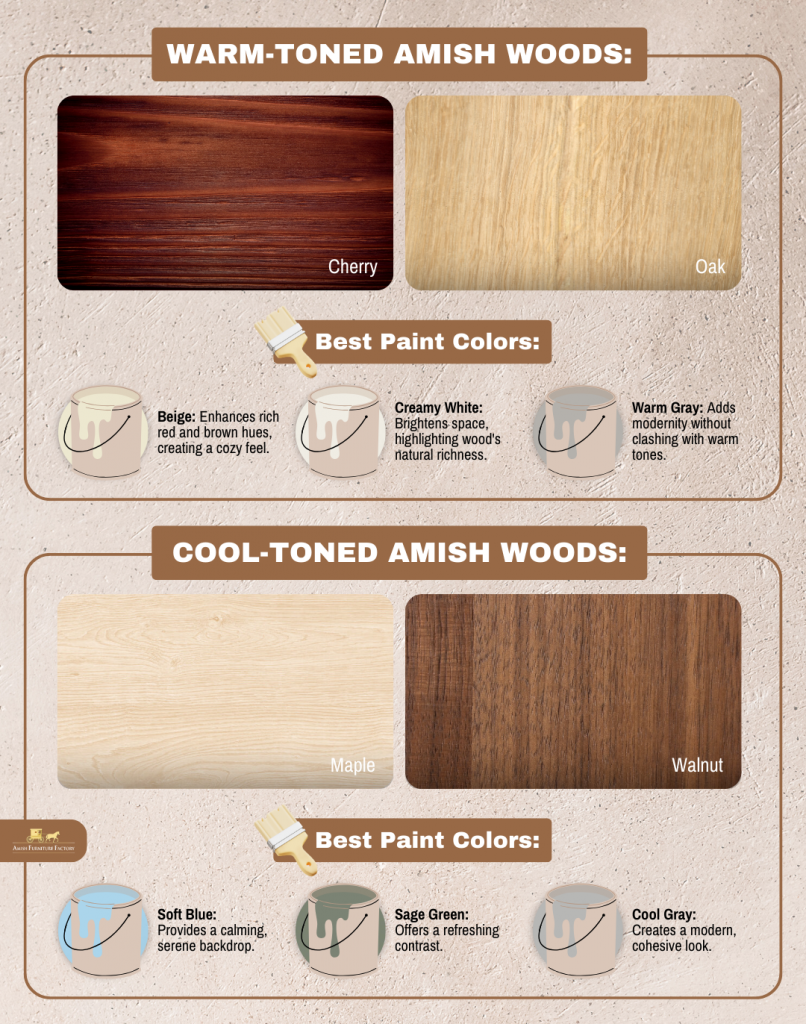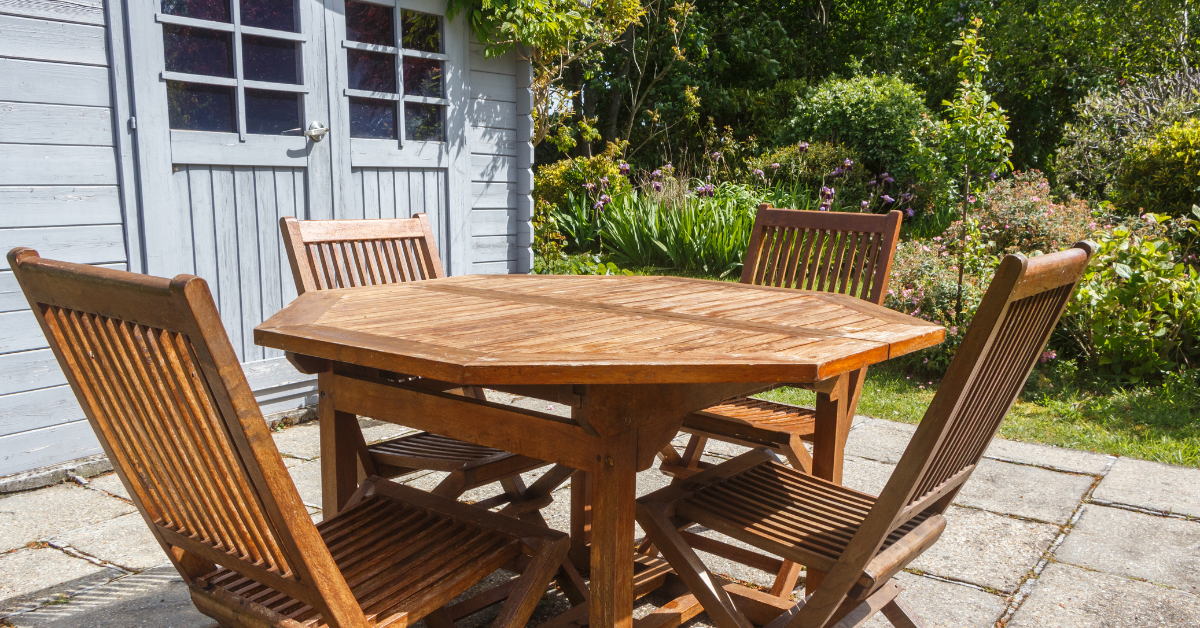
Amish furniture is celebrated for its timeless beauty and exceptional craftsmanship, making it a cherished addition to any home. However, selecting the perfect paint colors to complement these exquisite wood pieces can be a daunting task. The right color scheme can enhance the natural tones of the wood, creating a harmonious and inviting space.
Key Takeaways
- The type of wood and its natural hue greatly influence the choice of paint colors. Warm-toned woods like cherry and oak pair well with warm paint colors, while cool-toned woods like maple and walnut blend better with cool paint colors.
- Beige, creamy white, and warm gray are ideal paint options for warm-toned Amish woods, such as cherry and oak. These colors enhance the wood’s natural warmth and create a cohesive aesthetic.
- Soft blues, greens (like sage or mint), and cool grays are best for cool-toned Amish woods, such as maple and walnut. These colors highlight the wood’s subtle gray and purple undertones, creating a serene and elegant look.
- Testing paint samples in various lighting conditions is crucial. Natural and artificial lighting can significantly affect how paint colors appear, so it’s important to observe samples at different times of the day and under different light sources.
This article highlights the best paint colors and color schemes that pair beautifully with Amish furniture, providing you with practical tips and visual inspirations to elevate your home’s interior design.
Understanding Natural Tones and Finishes
Amish furniture is renowned for its high-quality craftsmanship and the use of rich, natural wood tones. Typically, Amish furniture features finishes that highlight the natural beauty of the wood, allowing the unique grains and textures to shine.
Common wood types for furniture include oak, cherry, maple, and walnut, each with its distinct undertones. Oak and cherry often exhibit warm undertones, presenting hues of red, brown, and gold. On the other hand, maple and walnut tend to have cooler undertones, showing shades of gray and even slight purples. These natural tones and finishes play a significant role in determining complementary paint colors.
The type of wood and its natural hue greatly influence the choice of paint colors for a harmonious look. For instance, warm-toned woods like cherry and oak pair beautifully with warm paint colors such as beige or creamy white. These colors accentuate the warmth of the wood and create a cohesive aesthetic. Conversely, cool-toned woods like maple and walnut blend well with cooler paint colors such as soft blues or greens, enhancing the natural elegance of the furniture.
Additionally, it’s important to consider the color of the room when painting your Amish furniture. The room’s color scheme should complement both the furniture and the paint colors chosen. For example, a room with neutral tones can serve as a versatile backdrop, allowing the furniture’s natural beauty to stand out. In contrast, a room with bold or vibrant wall colors may require more subdued paint choices for the furniture to maintain a balanced and harmonious appearance.
Selecting Paint Colors That Complement Amish Furniture
Choosing the right paint colors to complement Amish furniture involves considering the wood’s undertones and the desired ambiance of the room.
Warm-Toned Amish Woods
Warm-toned Amish woods, such as cherry and oak, exude a rich, inviting warmth that can be enhanced with the right paint colors. Beige is an excellent choice, as its neutral warmth complements the red and brown hues in cherry and oak, creating a seamless transition between the furniture and the walls. Creamy white is another great option, providing a light, airy feel that brightens the space while highlighting the wood’s natural richness. Warm gray, with its subtle undertones, can also pair beautifully, adding a touch of modernity without clashing with the wood’s warm tones.
Visual inspirations include living rooms with cherry wood cabinets paired with beige walls, creating a cozy, cohesive look. Dining areas featuring oak furniture against creamy white walls offer a bright, welcoming atmosphere perfect for gatherings. For a more contemporary feel, consider a bedroom with warm gray walls complementing cherry wood furniture, blending traditional and modern elements seamlessly.
Cool-Toned Amish Woods
Cool-toned Amish woods, like maple and walnut, benefit from paint colors that highlight their subtle gray and purple undertones. Soft blues are an ideal choice, providing a calming, serene backdrop that enhances the cool elegance of the wood. Greens, particularly sage or mint, can also work wonderfully, offering a refreshing contrast that complements the wood’s natural hues. Cool grays are versatile and sophisticated, creating a modern, cohesive look without overpowering the furniture’s natural beauty.
Examples of visual inspirations include a serene living room with soft blue walls and maple wood furniture, creating a tranquil, inviting space. Kitchens with walnut cabinets against cool gray walls offer a sleek, contemporary look that remains warm and inviting. For a touch of nature, consider a home office with sage green walls and maple wood accents, blending productivity with a refreshing, calming environment.

Accent Colors for Decorative Contrast
Accent colors play a crucial role in enhancing the overall aesthetic of a room with Amish furniture. When selecting decorative accents, consider colors that either complement or contrast with the wood tones.
For warm-toned woods, accents in warm hues like burnt orange, deep reds, and gold can add a cohesive look. These colors can be incorporated through throw pillows, rugs, or artwork, creating a rich and inviting space.
For cool-toned woods, accents in cooler shades like teal, lavender, or metallics can provide a striking contrast. These accents can be used in decorative items like vases, lamps, or cushions, adding visual interest and depth to the room. It’s important to balance the accent colors to ensure they enhance rather than overpower the natural beauty of the Amish furniture.
Here’s a simple checklist you can use as a guide when picking the perfect accent colors:

You might be interested to explore the top stain colors for tables.
Tips for Testing and Choosing Paint Colors
Selecting the perfect paint color involves more than just picking a shade you like. Testing and considering lighting conditions are crucial steps to ensure the chosen color complements your Amish furniture.
Sample Testing
Testing paint samples is essential to see how different colors interact with your Amish furniture. Begin by selecting a few paint samples that you think will complement the wood tones. Apply these samples on different walls in the room, considering how they look next to the furniture pieces. Observe the colors at different times of the day to see how natural light affects their appearance. This process helps in visualizing the final look and ensures the paint color enhances the beauty of the wood.
Using larger sample patches rather than small swatches can give a better sense of how the color will look on a larger scale. It’s also helpful to place the furniture next to the painted samples to see how they harmonize. This way, you can avoid any unpleasant surprises and make an informed decision about the best color for your space.
Ideal Types of Paints for Wood Furniture
Choosing the right type of paint for your Amish furniture is as important as selecting the right color. Here are a few types of paints that work well with wood furniture:
- Acrylic Paint: Known for its durability and resistance to cracking, acrylic paint is a popular choice for wood furniture. It dries quickly and is easy to clean, making it ideal for frequently used pieces.
- Chalk Paint: This paint gives a matte, vintage finish and is easy to distress, making it perfect for a rustic or shabby-chic look. Chalk paint adheres well to wood and requires minimal surface preparation.
- Milk Paint: Made from natural ingredients, milk paint provides a soft, rustic finish that complements the natural beauty of Amish furniture. It’s environmentally friendly and available in a variety of colors.
- Oil-Based Paint: While it takes longer to dry, oil-based paint offers a smooth, durable finish that can withstand heavy use. It’s ideal for high-traffic areas and pieces that require a hard, glossy finish.
- Latex Paint: Water-based and easy to clean up, latex paint is a versatile option that works well for wood furniture. It’s available in various finishes, from matte to glossy, allowing for a range of looks.
Selecting the right type of paint ensures that your furniture not only looks great but also stands the test of time.
Lighting Considerations
Lighting plays a significant role in how paint colors are perceived in a room. Natural light varies throughout the day, affecting the appearance of paint colors. South-facing rooms tend to have warmer, more intense light, which can make colors appear more vibrant. North-facing rooms receive cooler, softer light, which can make colors appear more subdued. When choosing paint colors for rooms with Amish furniture, consider how the natural light will interact with the wood tones.
Artificial lighting also impacts paint color perception. Incandescent bulbs emit a warm light that can enhance warm colors but may make cool colors look dull. LED and fluorescent lights come in various color temperatures, from warm to cool, and can influence how paint colors are perceived. Remember to test paint samples under the room’s lighting conditions to ensure the color complements the furniture both day and night.
Preparing Wood Furniture for Painting
Preparing Amish furniture for painting requires careful attention to detail to ensure a smooth and lasting finish. Here’s a step-by-step guide:
- The first step is to clean the furniture thoroughly. Use a mild detergent and water to remove any dust, dirt, or grease.
- Once the furniture is clean and dry, the next step is sanding. Sand the surface lightly with fine-grit sandpaper to remove any old finish and create a smooth base for the paint. Be sure to sand in the direction of the wood grain to avoid scratches and uneven surfaces.
- After sanding, wipe the furniture with a damp cloth to remove any dust particles.
- The final step is priming the furniture. Apply a high-quality wood primer to the entire surface, which helps the paint adhere better and provides a uniform base. Allow the primer to dry completely before applying the paint. For the best results, use a primer that is compatible with the type of paint you plan to use.
- Once primed, you can proceed with painting, applying multiple thin coats rather than one thick coat to achieve a smooth, even finish.
This careful preparation ensures that your painted Amish furniture will look beautiful and last for years.
Wrapping It Up: Enhancing Your Home with Amish Furniture and Paint
By considering these insights and tips, you can successfully select paint colors that beautifully complement your Amish furniture, enhancing its natural elegance and craftsmanship. Whether your pieces are made from warm-toned woods like cherry and oak or cool-toned woods like maple and walnut, the right paint choices can create a harmonious and inviting atmosphere in your home. Don’t forget to test paint samples and consider lighting conditions to ensure your chosen colors achieve the desired effect. With careful preparation and thoughtful color selection, your Amish furniture will continue to be a stunning focal point in your interior design for years to come.
FAQs
How do you maintain painted Amish furniture?
Maintaining painted Amish furniture involves regular dusting and cleaning with a soft, damp cloth. Avoid using harsh chemicals or abrasive cleaners, as they can damage the paint. To protect the finish, use coasters and placemats to prevent scratches and stains.
What are the latest trends in paint colors for wood furniture?
The latest trends in paint colors for wood furniture include muted and earthy tones like sage green, deep navy, and soft gray. These colors provide a modern yet timeless look that complements the natural beauty of wood. Bold accents like mustard yellow and teal are also popular for adding a touch of personality and vibrancy.
What is a complementary color to wood?
A complementary color to wood depends on the wood’s undertone. For warm-toned woods like cherry or oak, complementary colors include shades of blue or green. For cool-toned woods like maple or walnut, complementary colors include warm hues like red, orange, or yellow. These color combinations enhance the wood’s natural beauty and create a balanced, cohesive look.
